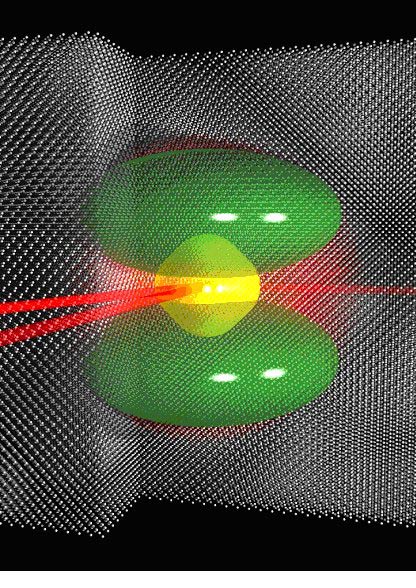
A new method controlling quantum states in silicon has been developed by an international team of physicists using giant “Rydberg atoms” created by doping the material with phosphorous impurities. The technique could be used to control quantum-computing devices made from silicon, while the solid-state Rydberg atoms themselves could provide physicists with a new tool for studying quantum mechanics.
Computers based on quantum-mechanical concepts such as entanglement could, in principle, out perform conventional computers on certain tasks. Although the scientific literature is full of schemes for quantum computers, physicists are yet to build practical devices capable of sustained quantum computations. However, some physicists believe that silicon-based devices could be the way forward.
The reason for their optimism is that nanometre-sized components can be made from ultrapure crystalline silicon – essential for minimizing unwanted noise that can destroy quantum information. Indeed, researchers have already shown that quantum bits (or qubits) of information can be stored for long periods of time in the spin states of impurity atoms in silicon. The snag, though, is that it has proved tricky to make these atoms interact and so process quantum information.
Superposition of states
Ben Murdin at the University of Surrey, researchers at University College London, the FOM Institute for Plasma Physics in the Netherlands and Heriot Watt University in Edinburgh have now shown that phosphorus-doped silicon could offer a way forward. The team used a commercially grown silicon crystal, which comes doped with a precise amount of phosphorus to boost its electron density. Each phosphorus atom has one more valence electron than silicon and so is like a giant hydrogen atom with a positive core and an electron in an orbital about 30 lattice spacings in diameter.
But unlike a conventional Rydberg atom, which is in a high-energy state, the impurity is normally in its lowest energy (ground) state. The team begin by putting each impurity atom into a combination of the ground and first excited states using a terahertz pulse from the FELIX free-electron laser in the Netherlands. In such a superposition of states an observer cannot know which state the impurity is in until a measurement is made – much like Schrödinger’s famous cat.
Slipping out of phase
The superposition state oscillates at a specific frequency that is defined in part by the magnetic moments of the neighbouring silicon atoms. Because there are several isotopes of silicon in the crystal the magnetic environment of each impurity is slightly different, which causes the oscillations of the impurities to slip out of phase with each other.
The team then fired a second terahertz pulse at the sample, which adjusted the relative phases of the impurities so that they all oscillated in unison. This resulted in a flash of light – called a “photon echo”. However, the photon echo occurs only if the impurities are in an superposition state. So by adjusting the delay between the two pulses and measuring the intensity of the echo, the team was able to deduce that the state lasted for about 160 ps.
Optical control
While this might seem like a short time, Murdin points out that it is nevertheless long enough to use the impurity to control neighbouring qubits. He believes that this could be done by placing spin-qubit impurities near Rydberg impurities such that their electron orbitals overlap. This would allow the qubits to be controlled using photons, which could help to reduce noise.
Murdin told physicsworld.com that his team is now working on a technique to position individual impurities to nanometre accuracy using the tip of a scanning probe microscope. First, they plan to place two phosphorus impurities next to each other and show that the quantum-control system can be used to entangle the two Rydberg atoms.
Jeremy O’Brien of Bristol University says that the possibility of quantum control using such Rydberg atoms is “exciting”. He adds that the work could open up a new area of physics research, comparing it to the emerging field of cavity quantum electrodynamics which grew out of studies of the interactions between light and quantum dots.
The work is reported in Nature 465 1057.



